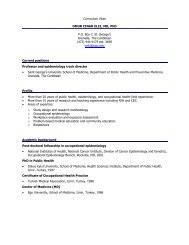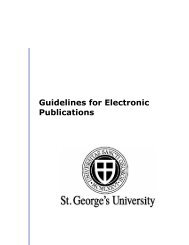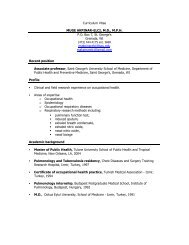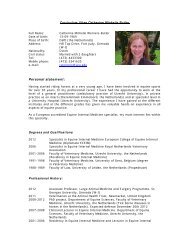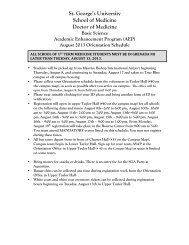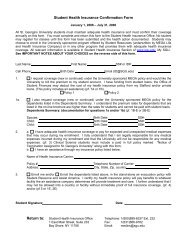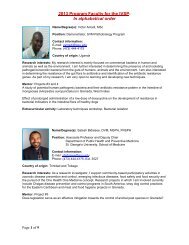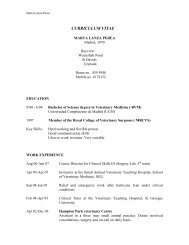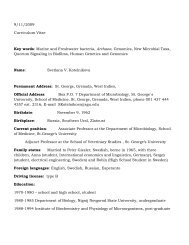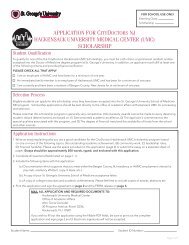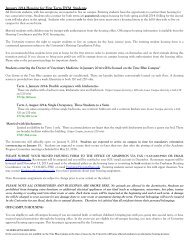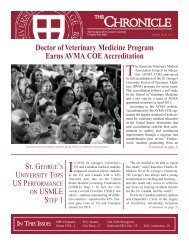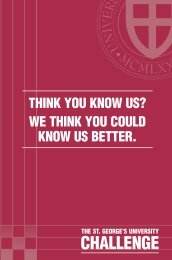SCHOOL OF 2012-2013 - St. George's University
SCHOOL OF 2012-2013 - St. George's University
SCHOOL OF 2012-2013 - St. George's University
You also want an ePaper? Increase the reach of your titles
YUMPU automatically turns print PDFs into web optimized ePapers that Google loves.
School of Medicine<br />
Course Descriptions<br />
This practical experience is felt to be a crucial part of<br />
any educator’s training. <strong>St</strong>udents are eligible to take this<br />
course twice. The first is Instructional Development I<br />
(ANAT 803) and the second is Instructional Development II<br />
(ANAT 813). <strong>St</strong>udents cannot apply these to the same core<br />
subject. If they elect to take both courses, they must select<br />
two of the four core anatomy courses (Human Gross and<br />
Developmental Anatomy, Embryology, Histology and Cell<br />
Biology, or Neuroanatomy). Letter grades will be based<br />
on the course director’s evaluation and the delivered<br />
lectures to colleagues and other course instructors, as well<br />
as to students of the course. The subjective evaluation<br />
of attendance and work effort in relevant labs, as well as<br />
the quality of oral presentations will be considered as a<br />
component of the grade. It is intended that students will be<br />
formally evaluated at the end of the term by the students of<br />
the course, but it is up to the course director as to whether<br />
or not to use this feedback in their evaluation.<br />
ANAT 804<br />
Seminar in Anatomical Sciences<br />
A core course requirement for the MSc and PhD, this<br />
course aims to provide an awareness of important current<br />
issues in clinical anatomy education and improve student<br />
understanding of both the educational issues confronting<br />
the profession and the ethical issues associated with the<br />
use of human tissue. Members of the department will meet<br />
with graduate students to discuss topics, to be determined<br />
by the course director, that are issues in the field of clinical<br />
anatomy education. The seminar will be held three times<br />
each term and graduate students will participate in the<br />
seminar for a minimum of four terms. The course is graded<br />
as satisfactory/unsatisfactory and performance will be<br />
determined by the level of student participation in the<br />
discussions over the four terms.<br />
ANAT 820<br />
Graduate Gross Anatomy<br />
An independent study course that aims to provide<br />
graduate students with the knowledge of gross anatomy<br />
necessary for postgraduate teaching, Graduate Gross<br />
Anatomy goes beyond the level attained in the Human<br />
Gross and Developmental Anatomy (ANAT 550) course<br />
and includes historical perspectives and anatomical<br />
variation. <strong>St</strong>udents will be responsible for preparing<br />
full-body prosection following the same sequence as the<br />
dissection in Human Gross and Developmental Anatomy.<br />
The prosection will be used as a teaching specimen for<br />
current ANAT 550 students. <strong>St</strong>udents will work under the<br />
supervision of a full-time member of the department.<br />
<strong>St</strong>udents will be responsible for assigned readings<br />
for the area prosected and will be evaluated by oral<br />
examination periodically. The course will be taken the term<br />
immediately following the completion of Human Gross and<br />
Developmental Anatomy.<br />
ANAT 831<br />
Anatomy Prosection and Preservation<br />
The goals of this course are to improve students’<br />
understanding of a region or regions, improve their<br />
dissection and presentation skills, develop a body of<br />
high-quality teaching materials with anatomic purpose,<br />
and develop the ability to discuss and educate others<br />
on a particular region of the body. Graduate students<br />
are provided the opportunity to enhance their general<br />
anatomical knowledge and explore in far greater detail<br />
areas of the body that were covered only superficially<br />
in their previous coursework. They will learn the finer<br />
anatomical points of the body, as well as be exposed to<br />
and trained in the various means of specimen preparation,<br />
preservation, and display available today. They will be able<br />
to revisit anatomical areas of interest to obtain a deeper<br />
understanding of those areas, in addition to the production<br />
and study of detailed anatomical preparations for future<br />
application in their teaching careers. This one- or two-term<br />
course will give participants the opportunity to undertake<br />
detailed, professional-quality dissections of the human<br />
body. The various techniques involved in the preparation<br />
of cadaveric material for display and teaching include dry<br />
bone/ligamentous preps, plastic embedding, and various<br />
plastination procedures. This course gives a letter grade<br />
and involves 24 lecture hours and 70 lab hours. A formal<br />
50-minute seminar/presentation must be presented to<br />
departmental faculty and invited guests a minimum of<br />
twice per term, as well as a formal presentation of the<br />
students’ finished program projects will be given to peers<br />
and faculty.<br />
ANAT 980<br />
Research for the PhD<br />
10 credits<br />
ANAT 991<br />
Doctoral Dissertation in PhD<br />
9 credits<br />
78 | <strong>St</strong>. George’s <strong>University</strong>



